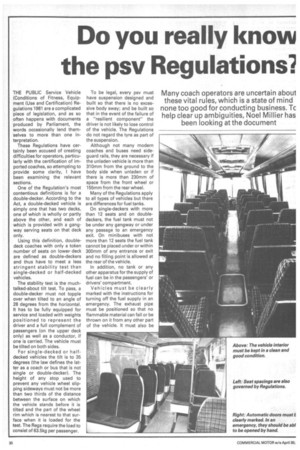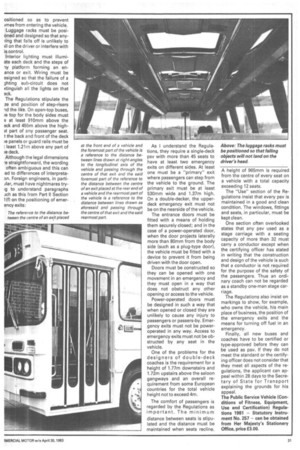Do you really know the psv Regulations?
Page 32

Page 33

If you've noticed an error in this article please click here to report it so we can fix it.
Many coach operators are uncertain about these vital rules, which is a state of mind none too good for conducting business. Tc help clear up ambiguities, Noel Millier has been looking at the document
THE PUBLIC Service Vehicle (Conditions of Fitness, Equipment (Use and Certification) Regulations 1981 are a complicated piece of legislation, and as so often happens with documents produced by Parliament, the words occasionally lend themselves to more than one interpretation.
These Regulations have certainly been accused of creating difficulties for operators, particularly with the certification of imported coaches, so attempting to provide some clarity. I have been examining the relevant sections.
One of the Regulation's most contentious definiions is for a double-decker. According to the Act, a double-decked vehicle is simply one that has two decks, one of which is wholly or partly above the other, and each of which is provided with a gangway serving seats on that deck only.
Using this definition, doubledeck coaches with only a token number of seats on lower deck are defined as double-deckers and thus have to meet a less stringent stability test than single-decked or half-decked vehicles.
The stability test is the muchtalked-about tilt test. To pass, a double-decker must not topple over when tilted to an angle of 28 degrees from the horizontal. It has to be fully equipped for service and loaded with weights positioned to represent the driver and a full complement of passengers (on the upper deck only) as well as a conductor, if one is carried. The vehicle must be tilted on both sides.
For single-decked or halfdecked vehicles the tilt is to 35 degrees (the taw defines the latter as a coach or bus that is not single or double-decker). The height of any stop used to prevent any vehicle wheel slipping sideways must not be more than two thirds of the distance between the surface on which the vehicle stands before it is tilted and the part of the wheel rim which is nearest to that surface when it is loaded for the test. The Regs require the load to consist of 63.5kg per passenger. To be legal, every psv must have suspension designed and built so that there is no excessive body sway; and be built so that in the event of the failure of a "resilient component" the driver is not likely to lose control of the vehicle. The Regulations do not regard the tyre as part of the suspension.
Although not many modern coaches and buses need sideguard rails, they are necessary if the unladen vehicle is more than 310mm from the ground to the body side when unladen or if there is more than 230mm of space from the front wheel or 155mm from the rear wheel.
Many of the Regulations apply to all types of vehicles but there are differences for fuel tanks.
On single-deckers with more than 12 seats and on doubledeckers, the fuel tank must not be under any gangway or under any, passage to an emergency exit. On minibuses with not more than 12 seats the fuel tank cannot be placed under or within 300mm of any entrance or exit and no filling point is allowed at the rear of the vehicle.
In addition, no tank or any other apparatus for the supply of fuel can be in the passengers' or drivers' compartment.
Vehicles must be clearly marked with the instructions for turning off the fuel supply in an emergency. The exhaust pipe must be positioned so that no flammable material can fall or be thrown on it from any other part of the vehicle. It must also be ositioned so as to prevent Ames from entering the vehicle. Luggage racks must be posioned and designed so that anyling that falls off is unlikely to ll on the driver or interfere with is control.
Interior lighting must illumiate each deck and the steps of ny platform forming an enance or exit. Wiring must be esigned so that the failure of a ghting sub-circuit does not dinguish all the lights on that eck.
The Regulations stipulate the ze and position of step-risers nd the like. On open-top buses, le top for the body sides must e at least 910mm above the eck and 455m above the highst part of any passenger seat. t the back and front of the deck ie panels or guard rails must be I least 1.21m above any part of le deck.
Although the legal dimensions re straightforward, the wording often ambiguous and this can ,ad to differences of interpretaon. Foreign engineers, in partiAar, must have nightmares tryig to understand paragraphs Jai as this from Part 11 Section 1(f) on the positioning of emerency exits:
at the front end of a vehicle and the foremost part of the vehicle is a reference to the distance between lines drawn at right-angles to the longitudinal axis of the vehicle and passing through the centre of that exit and the said foremost part of the reference to the distance between the centre of an exit placed at the rear end of a vehicle and the rearmost part of the vehicle is a reference to the distance between lines drawn as aforesaid and passing through the centre of that exit and the said rearmost part.
As I understand the Regulations, they require a single-deck psv with more than 45 seats to have at least two emergency exits on different sides. At least one must be a "primary" exit where passengers can step from the vehicle to the ground. The primary exit must be at least 530mm wide and 1.37m high. On a double-decker, the upperdeck emergency exit must not be on the nearside of the vehicle.
The entrance doors must be fitted with a means of holding them securely closed; and in the case of a power-operated door, when the door projects laterally more than 80mm from the body side (such as a plug-type door), the vehicle must be fitted with a device to prevent it from being driven with the door open.
Doors must be constructed so they can be opened with one movement in an emergency and they must open in a way that does not obstruct any other opening or access to the vehicle.
Power-operated doors must be designed in such a way that when opened or closed they are unlikely to cause any injury to passengers or passers-by. Emergency exits must not be poweroperated in any way. Access to emergency exits must not be obstructed by any seat in the vehicle.
One of the problems for the designers of double-deck coaches is the requirement for a height of 1.77m downstairs and 1.72m upstairs above the saloon gangways and an overall requirement from some European countries for the total vehicle height not to exceed 4m.
The comfort of passengers is regarded by the Regulations as important. The minimum distance between seats is stipulated and the distance must be maintained when seats recline. A height of 965mm is required from the centre of every seat on a vehicle with a total capacity exceeding 12 seats.
The "Use" section of the Regulations insist that every psv is maintained in a good and clean condition. The windows, fittings and seats, in particular, must be kept clean.
One section often overlooked states that any psv used as a stage carriage with a seating capacity of more than 32 must carry a conductor except when the certifying officer has stated in writing that the construction and design of the vehicle is such that a conductor is not required for the purpose of the safety of the passengers. Thus an ordinary coach can not be regarded as a standby one-man stage carriage.
The Regulations also insist on markings to show, for example, who owns the vehicle, his main place of business, the position of the emergency exits and the means for turning off fuel in an emergency.
Finally, all new buses and coaches have to be certified or type-approved before they can be used as psv. If they do not meet the standard or the certifying officer does not consider that they meet all aspects of the regulations, the applicant can appeal within 28 days to the Secretary of State for Transport explaining the grounds for his appeal.
The Public Service Vehicle (Conditions of Fitness, Equipment, Use and Certification) Regulations 1981 — Statutory Instrument No. 257 — can be obtained from Her Majesty's Stationery Office, price MN.




































































































